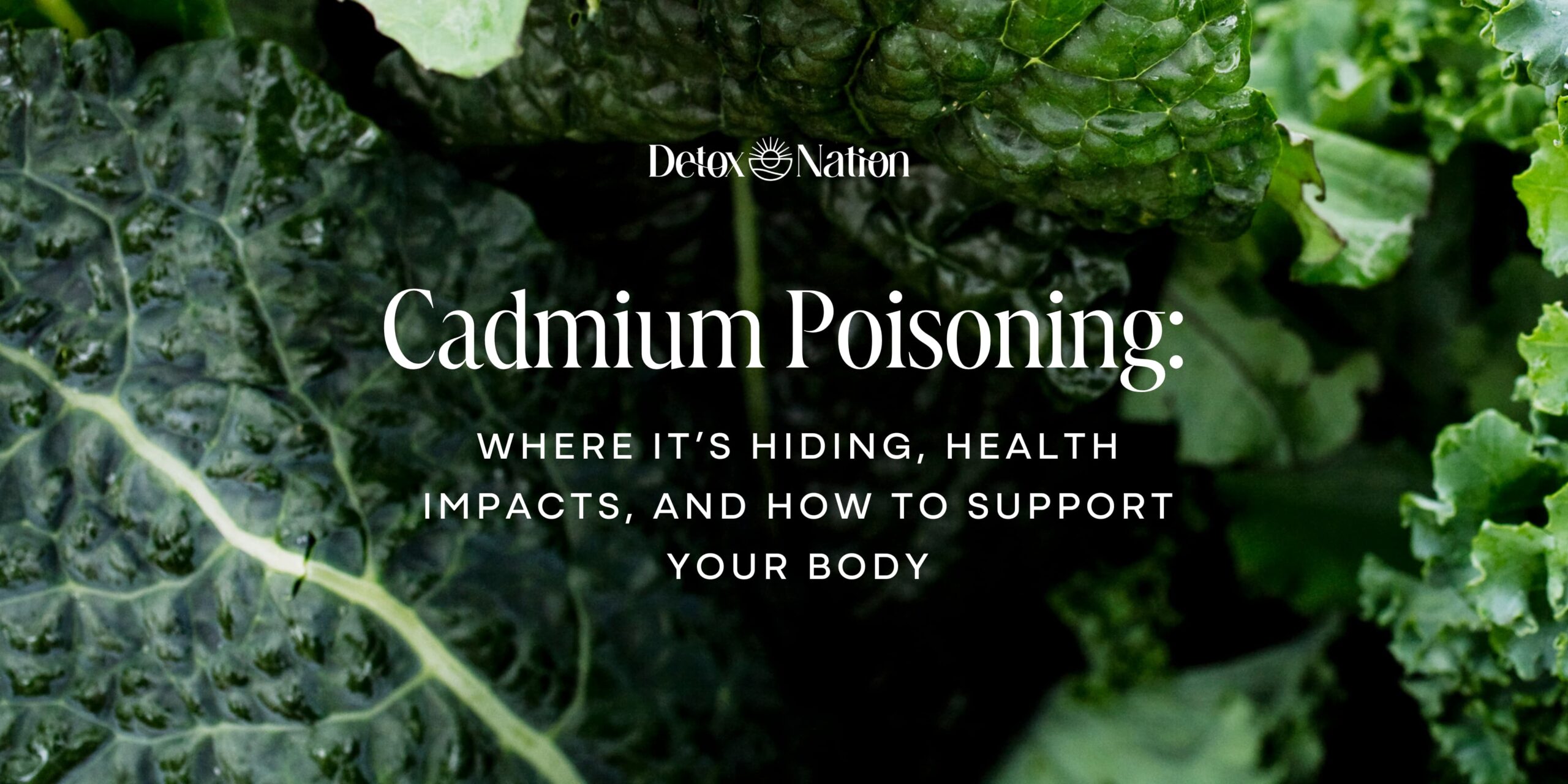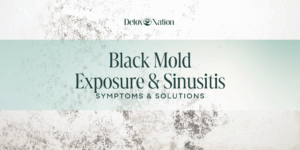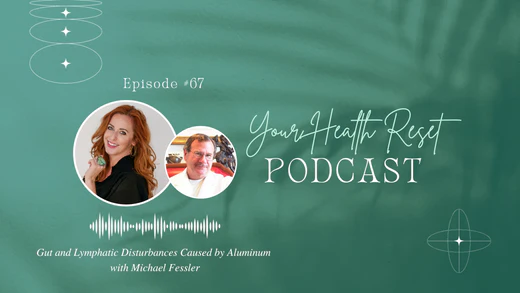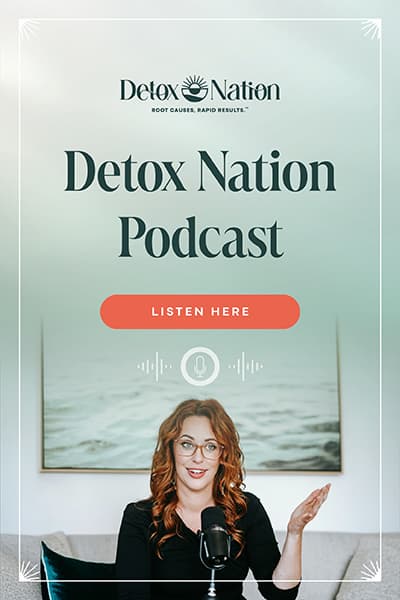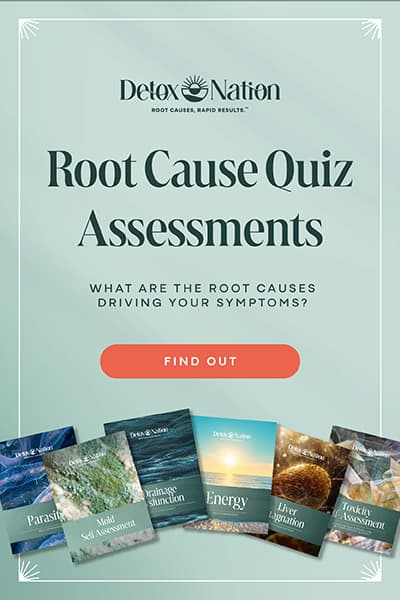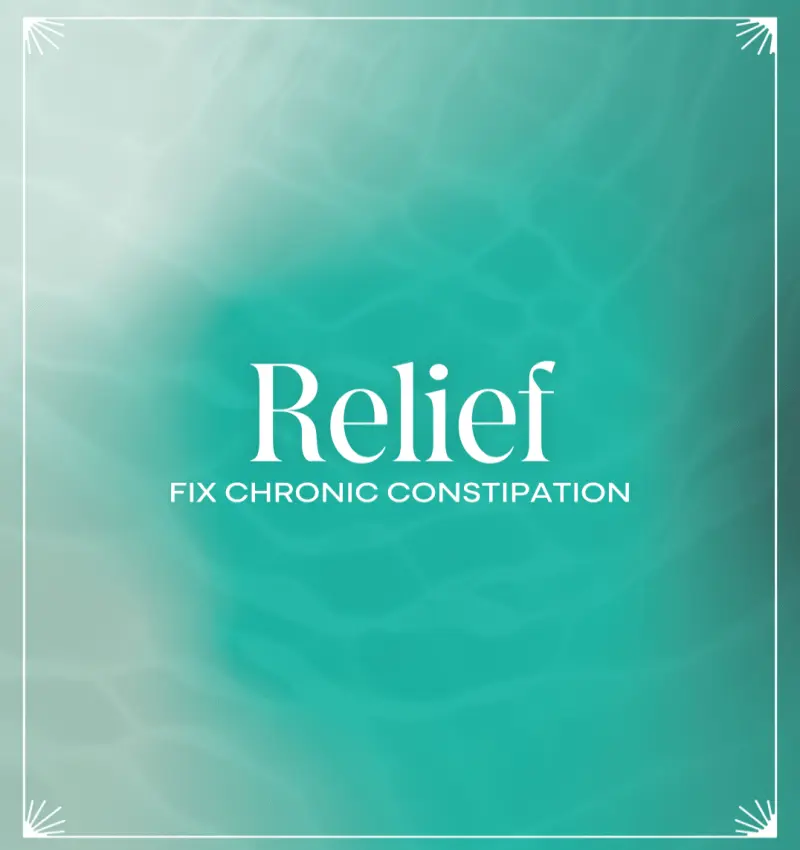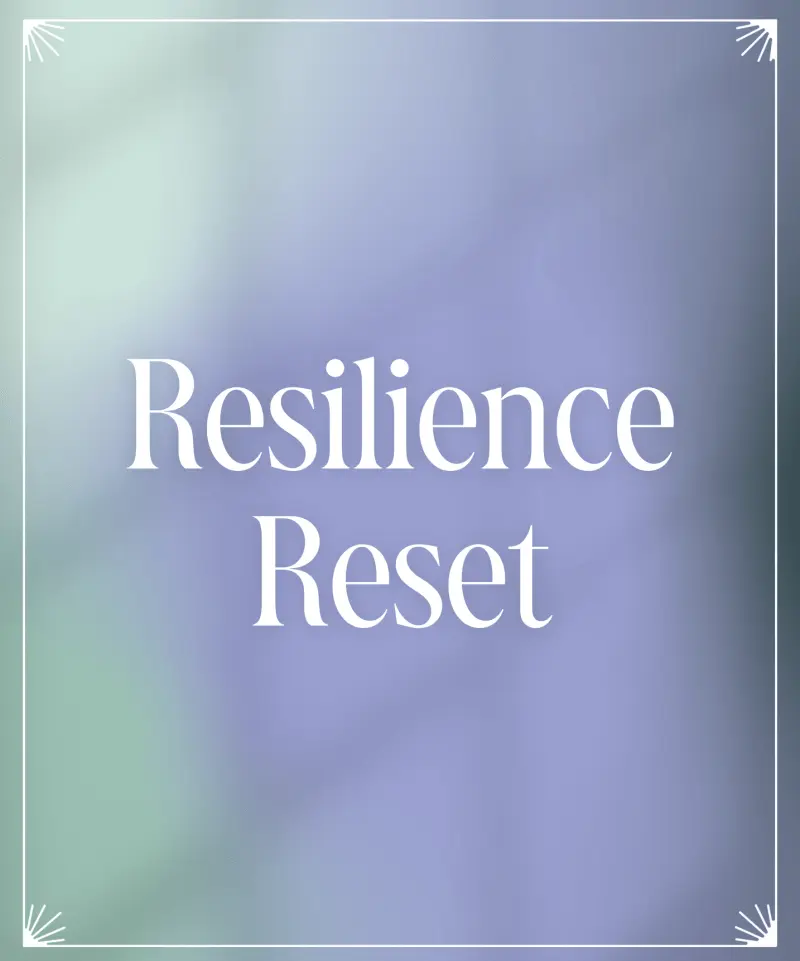Cadmium poisoning doesn’t just happen in factories—it’s happening in kitchens, gardens, and wellness routines. Here’s what you need to know.
You’ve done all the things—the elimination diets, the bio hacks, the labs.
You gave up gluten, dairy, your favorite wine, and the last of your patience.
You swapped out your cookware, stopped using plastic, and you haven’t microwaved a meal since Obama was in office.
So why are you still exhausted?
Why are your joints aching, your brain foggy, your gut unpredictable?
Why do your labs come back “normal” while your body clearly disagrees?
Perhaps you’re quietly being poisoned by a toxic metal you’ve never thought about—cadmium.
And if that sounds dramatic, I wish it were.
Cadmium (Cd) is an industrial heavy metal that acts like a biochemical wrecking ball.
It poisons your mitochondria, disrupts hormones, weakens your bones and teeth, and plays dirty with your brain and kidneys.
And because cadmium bioaccumulates over time, a little exposure adds up. Every year, every bite, every breath—it stays with you.
Since I don’t talk about things that aren’t winnable, this article isn’t just a warning—it’s a guide. You’ll learn how cadmium sneaks into your life, how it damages your body, and what you can do to get it out—for good.
Stop Guessing. Start Healing.
If you're ready to go deeper, our Healing Labs offer real, tissue-level testing that reveals what your bloodstream can’t. This is where clarity begins.
Explore Healing LabsWhat Is Cadmium, and Why Should You Care?
Let’s get one thing straight: cadmium doesn’t belong in your body.
It serves zero biological purpose—no helpful role, no redeeming qualities, no “well in moderation…” justification (4, 11).
And yet, thanks to modern life, it’s probably in you right now.
Cadmium is a heavy metal released through industrial processes like mining, smelting, and fossil fuel combustion.
It leaches into our water, sneaks into crops, and settles into our air.
If you’ve ever lived near a freeway, sipped tea, lit a joint, or enjoyed a square of dark chocolate, congratulations—you’ve been exposed.
You don’t need a high dose to feel the effects because cadmium is cumulative and persistent (7, 21, 28).
Cadmium may be the toxic thread weaving through your fatigue, your brain fog, your hormonal crashes—and no one ever told you it was there.
It’s not your fault. But your body is your responsibility.
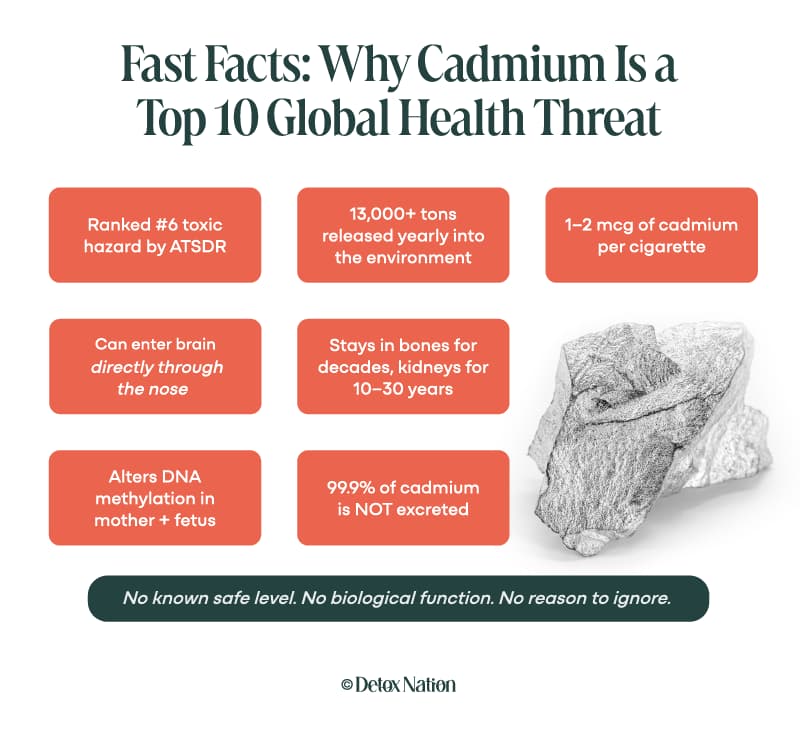
Cadmium Curiosities: What This Heavy Metal Hopes You Never Find Out
Here are some quick facts about Cadmium, taken directly from recent studies:
- Earth sources of Cadmium are rare. The amount of cadmium found in a ton of material from the Earth’s crust is equivalent to “less than one-fifth of the metal in a thumbtack.” (25).
- Over 13,000 tons are produced every year and released into the environment (9, 25).
- Depending on the reference, the half-life of cadmium in human tissue is 10-30 years (4, 9, 11, 13, 28, 30).
- Of the cadmium you inhale, 10-50% is absorbed by your body (9, 25, 28).
- Cadmium is ranked sixth among the top ten priority hazards classified by the Agency for Toxic Substances and Disease Registry (5, 28).
- Studies indicate a cadmium-exposure DNA methylation pattern or “footprint” in maternal and fetal DNA, effecting gene expression and function (5).
- Cadmium can directly enter the central nervous system through your nose, bypassing the protective blood-brain-barrier (5).
- “Over time, heavy metals can become a permanent component of certain body parts such as the bones, kidneys, liver, and brain due to their long half-life.” (15).
- There’re 1-2 micrograms of cadmium in one cigarette (9, 11, 25, 28).
- Because cadmium doesn’t degrade easily and it’s continually being produced, the amount in the environment is constantly increasing (28).
- Humans don’t eliminate cadmium easily; therefore, the clearance rate is only about 0.007% to 0.009% for urine and feces, respectively (4, 28).
- Exposure is related to hormone receptor-positive and HER2 positive breast cancer (26).
- Iron deficiency increases intestinal absorption, thus menstruating women are more vulnerable to Cadmium than men (9, 26, 28).
- Approximately 50-75% of cadmium in the body is in the kidneys and liver (28).
- Cadmium can prevent proper nutrition and oxygenation of a fetus, and it can accumulate in the fetal tissue (28).

Sources of Exposure to Cadmium
Let’s break down the most common ways cadmium sneaks into your body: Environmental cadmium, cadmium in soil, cadmium in the air, cigarette smoke, and dietary cadmium exposure.
1. Contaminated Water
Cadmium can slip into drinking water from industrial runoff, mining waste, and corroded pipes—especially if you’re on a private well (5, 6, 11, 19, 25, 27, 30).
It’s tasteless and odorless, so unless you’re testing regularly, you’d never know it’s there.
City water isn’t off the hook either; most treatment plants aren’t filtering for metals like cadmium.
2. Soil and Groundwater (Yes, Even in Organic Farming)
Cadmium builds up in soil over time from phosphate fertilizers, sewage sludge, and nearby industrial activity (5, 6, 11, 19, 24, 25, 30).
Plants grown in contaminated soil soak it right up—especially long-rooted crops like tea, cocoa, leafy greens, and rice.
And no, organic certification (no pesticides) doesn’t guarantee it’s cadmium-free.
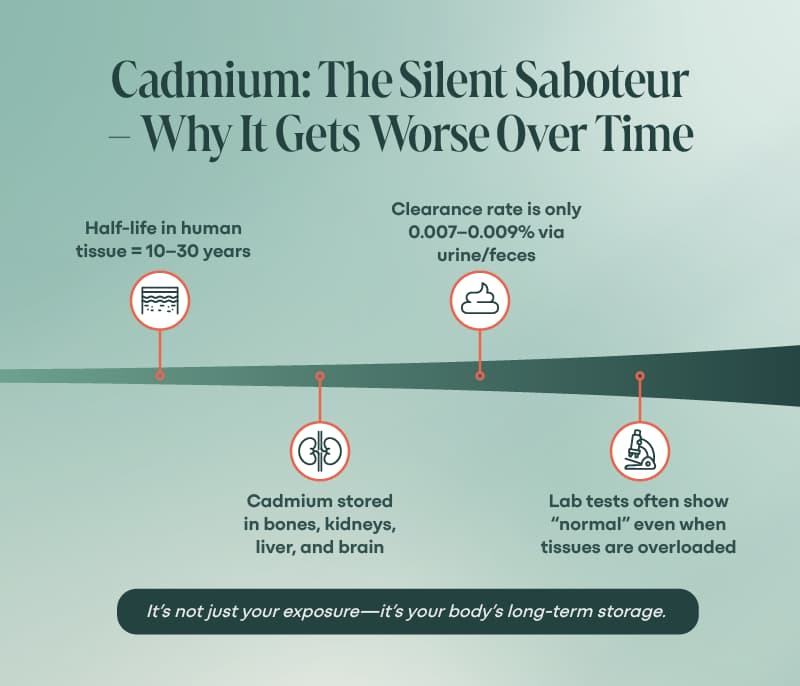
3. Inhalation of Cadmium: Country Mouse or City Mouse, You’re Still Exposed
Living near busy roads?
Cadmium is released from fertilizer use, tire wear, brake dust, and fuel combustion (5, 6, 24, 25.)
It settles in agricultural dust and road dust, which means every time the wind kicks up, you could be inhaling tiny, metal-laced particles (3, 9, 24).
This is especially rough on kids, pregnant women, and anyone with a compromised detox system (aka, most people with chronic symptoms) (5, 21, 23).
Living in modern life—replete with the conveniences brought by nickel-cadmium batteries, metal coatings, ore mining, alloys, landfills, phosphate fertilizers, waste incineration, steel production, plastics, pesticides, and more—exposes you to cadmium no matter where you live (2, 3, 5, 6, 9, 19, 25, 26).
4. Secondhand & Thirdhand Tobacco Smoke (and Marijuana)
Tobacco and marijuana plants both concentrate cadmium from the soil (5, 8), and when they’re smoked?
That cadmium becomes airborne.
Whether for sleep, pain relief, or just catching a break from the dumpster fire that is modern life, cannabis use is more common than ever.
Even if you’re not the one lighting up, exposure from someone else’s habit—or from surfaces and fabrics in a smoky environment—can still get under your skin, literally (2, 5, 6, 11, 24) .
Unless it’s grown in clean, tested soil (rare), you’re inhaling that cadmium straight into your bloodstream.
Or delivering it to your intestines via edibles and other products (8).
From there, a direct line to your liver, your brain, and your long-suffering kidneys.
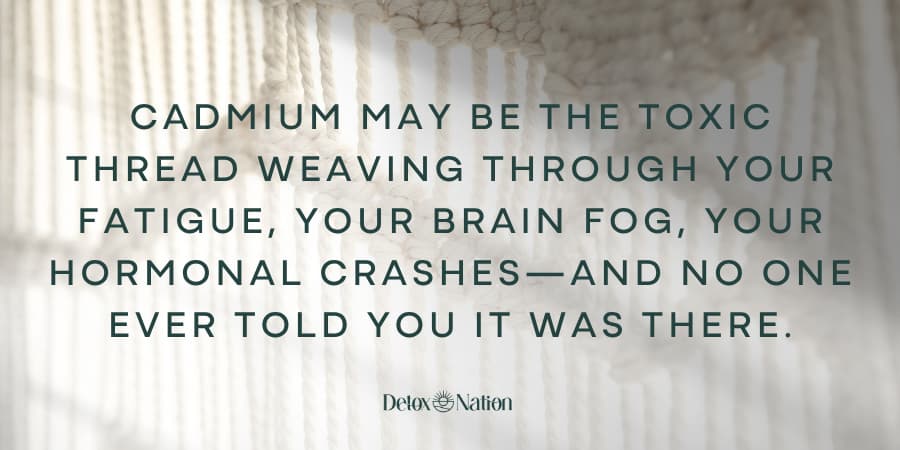
5. Forest Fires
This one’s rarely discussed, but it matters—especially if you live in the Western U.S. or Canada.
Trees absorb cadmium over decades from contaminated soil and air.
When they burn in wildfires, that cadmium is released into the atmosphere and can travel for hundreds of miles (28).
The air might smell like pine and smoke, but it’s also carrying fine particulate metals for the Firefighters—and you—to inhale (18, 20).
The ash settles into the soil, and the cycle starts again (20).
6. Dark Chocolate
Now for the heartbreak: chocolate. Specifically, dark chocolate—the kind you eat because it’s “good for you.”
And it is… until it isn’t.
Cocoa trees have deep roots, which means they pull minerals—and metals—from far down in the soil (1, 13).
Even major organic and fair-trade brands have failed independent cadmium testing (31).
A 2023 Consumer Report found brands like Alter Ego and Pascha with over 200% of California’s Maximum Allowable Dose of cadmium (31).
The safest choice was Ghirardelli’s Intense Dark Chocolate 86% Cacao bar with only 39% of the CMAD (31). (You’re welcome!)
Shockingly, there’s no requirement to list cadmium on the label. So, unless you’re nerding out with third-party lab reports (which—hi, welcome to the club), you won’t know what you’re consuming.
If you’re a daily chocolate eater, this exposure adds up fast. Especially if your body’s drainage and mineral systems are already compromised.
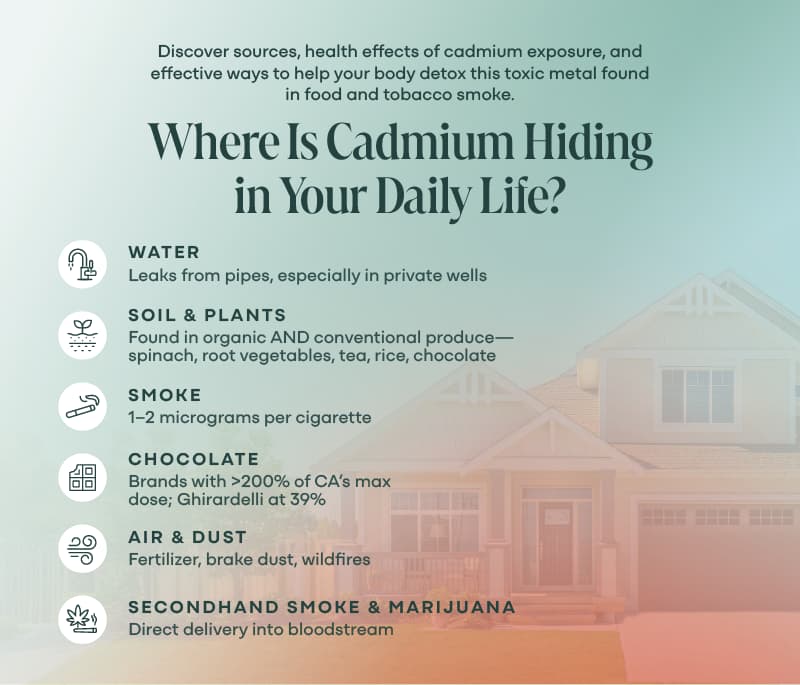
7. Contaminated Food Sources
Nutrient-dense foods are great for detox—unless the soil they’re grown in is contaminated (3, 5, 6, 11, 19, 22, 24, 25, 26, 27, 30).
- Spinach, lettuce, kale: These are quick growers and heavy metal accumulators.
- Beets, carrots, potatoes: Root veggies dig deep and don’t discriminate between magnesium and cadmium (25).
- Rice: Especially from areas using phosphate fertilizers or with arsenic in the water supply—cadmium often tags along (25, 28).
- Spices: Those such as ginger, turmeric, thyme, cumin, paprika, oregano, and basil may be contaminated with metals, including cadmium (31).
- Tea: (10) Because tea leaves aren’t peeled, shelled, or scrubbed down, whatever’s in the soil ends up steeping in your cup.
Cadmium bioaccumulates in animals as well as plants (3, 6, 8, 9, 25, 27).
Imagine a small fish that’s been exposed to cadmium. That fish is eaten by a bigger fish who was exposed to cadmium in the water, and the concentrated metal in its snack. That fish is eaten by an even larger fish, and so on…until you enjoy that piece of cadmium-laced sushi.
The highest food-source concentrations of cadmium are found in animal liver and kidneys, and in shellfish (25).
So, what do you do—swear off food? No. Please don’t.
The reality of modern eating is that your food may be your medicine or your metal exposure—depending entirely on the terrain it came from.
Once you know your exposure, you can support your body to let it go. We’ll get to how.
But first, let’s talk about what cadmium does once it’s in your body—and why it’s such a nightmare for your health.

Health Effects of Cadmium Exposure: Symptoms & Systems
Once it’s in your body, cadmium disrupts nearly every system—and not in subtle ways.
Mitochondria: The First Victims
Your mitochondria are the energy powerhouses of your cells—tiny engines that convert nutrients into ATP (aka, cellular energy). They’re also incredibly sensitive.
Cadmium? It walks in and derails the entire operation.
- It interferes with the electron transport chain (basically the core of energy production) (9, 26).
- It displaces essential minerals like zinc, magnesium, and selenium, which your mitochondria need to function (9, 26).
- It indirectly increases free radical formation (9, 26, 28).
- And it promotes oxidative stress, damaging the mitochondrial membrane—think rusty wiring and leaky pipes on a cellular level (6, 7, 9, 26, 28).
It also destroys antioxidant activity:
- Suppresses glutathione production (9, 26, 28)
- Depletes the precursors you need to make more
- And blocks the enzymes required for glutathione to do its job
It’s like lighting your house on fire and stealing your fire extinguisher on the way out.
The result? Mitochondrial dysfunction (26, 28), including:
- Crushing fatigue
- Poor recovery from exertion
- That tired-but-wired feeling where your body wants to lie down, but your nervous system is doing jumping jacks
Let’s explore the other symptoms of cadmium toxicity.
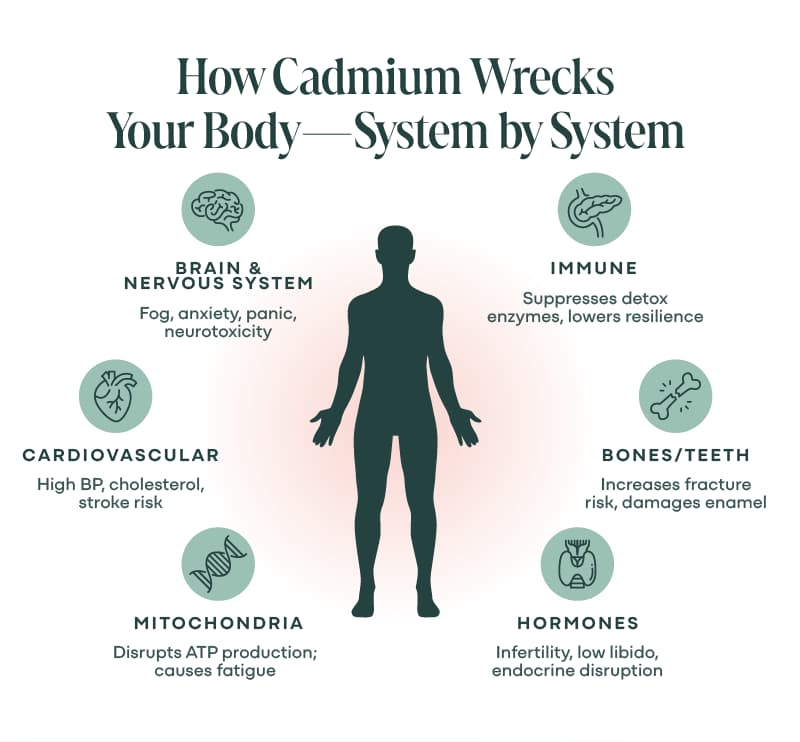
Symptoms – AKA, Your Body Trying to Tell You Something
Cadmium doesn’t cause one “disease”—it creates dysfunction across multiple systems. Let’s break it down:
Systemic Impacts:
- Human carcinogen (5, 6, 9, 11, 18, 23, 28)
- Kidney, lung, liver, prostate, bladder, stomach, pancreas
- Impaired stem cell differentiation (5, 12, 28)
- Changes in genetic expression and regulation (5, 12, 28)
- Impaired vision—glaucoma, cataracts, macular degeneration (6)
- Protein misfolding (6)
Nervous System & Brain
- Brain fog and memory loss
- Mood swings, depression, anxiety, and even panic attacks
- Learning disabilities and cognitive delays (especially in kids) (5, 23)
- Insomnia or unrestful sleep (27)
- Neurotoxicity (5, 23, 24)
- Neurodegeneration (17)
Energy & Immunity
- Fatigue that sleep doesn’t fix (27)
- Blood sugar instability and adrenal burnout
- Disrupted immune function (29)
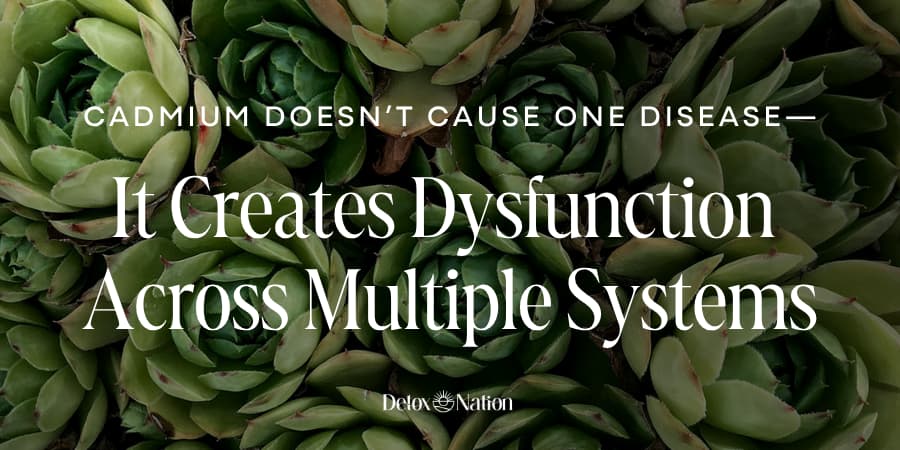
Hormonal Health
- Known endocrine disruptor (4, 27, 28)
- Male infertility, decreased sperm count and motility in men; testicular damage (28)
- Low libido, irregular cycles, and impaired female reproduction (4, 6, 25, 28)
- Ovarian damage (4, 28)
Kidneys & Liver
- Kidney dysfunction or damage (2, 4, 5, 9, 11, 15, 23, 24, 25)
- Water retention or frequent urination (9)
- Liver damage (4, 15, 24, 25, 28)
- Poor bile flow and sluggish liver detox
Respiratory System
- COPD (9)
- Respirotoxic (9, 24)
Digestive System
- Nausea, GERD, bloating, cramping (23, 25)
- Diarrhea or constipation (or, lucky you—both!) (23, 25)
- Poor nutrient absorption despite eating clean
Cardiovascular & Circulatory
- Suppresses Nitric Oxide and alters blood pressure regulation (9)
- Increased risk of stroke (9)
- Cardiovascular inflammation and arterial stiffness (9)
- Promotes atherosclerosis (9)
- Increases cholesterol levels (9)
- Cardiovascular disease (9, 11)
Structural & Dental
- Increased risk of osteopenia, osteoporosis, and fractures (5, 9, 11, 15, 23)
- Cavities and tooth deformities despite good oral hygiene
If cadmium is messing with your mitochondria, depleting your glutathione, and triggering chronic inflammation—it makes perfect sense that you’re tired, foggy, inflamed, and struggling to heal.
Your body is brilliant. It’s not broken. It’s overwhelmed and sending up flares.
And this isn’t just happening in adults.
Maternal or childhood cadmium exposure has been linked to learning disabilities, behavioral issues, and delayed development (5, 23).
It’s not your fault—we’re living in a world that wasn’t designed for human health. (But it’s fixable!)
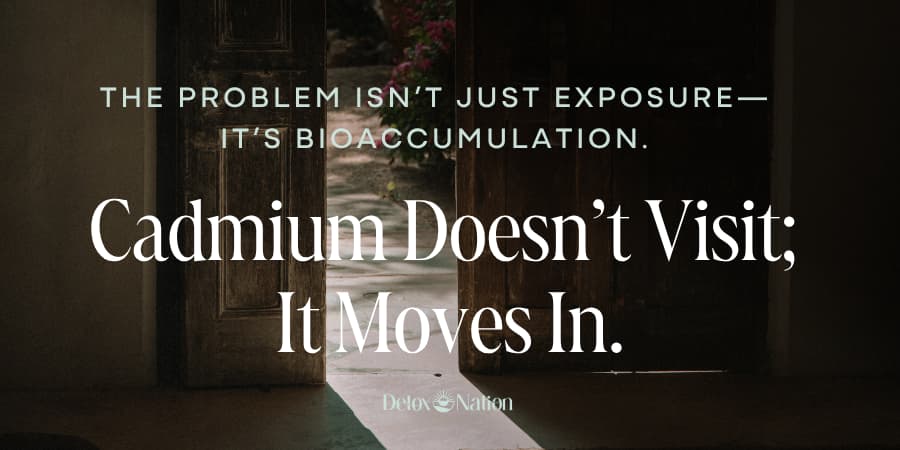
Cadmium Bioaccumulation – Why It Gets Worse Over Time
It’s not just how much cadmium you’re exposed to—it’s how long it stays in you.
It’s setting up camp. In your kidneys. Your bones. Your brain. And it’s not leaving on its own.
This is what’s known as bioaccumulation—and it’s the real reason so many people are still sick despite their best efforts.
The Body’s “Keep It Quiet” Strategy
Cadmium is too dangerous to leave floating around in the bloodstream.
Your body, in its brilliance, locks it away in tissues and bones to keep it from doing more damage.
It’s not ideal, but it’s a survival move—kind of like sweeping broken glass under the rug because you don’t have a dustpan.
This means:
- Blood tests often show nothing unless you’ve had a recent acute exposure.
- You can “look fine” on labs while your tissues are basically holding a toxic debt.
- Even if your last exposure was years ago, you can still be dealing with the fallout today.
Cadmium’s half-life in the body is decades. It’s estimated to linger in the kidneys for 10–30 years, and in bones for even longer (4, 9, 11, 13, 28, 30).
So, if your exposure started in childhood—or even before, via maternal transfer—your body could still be carrying that burden now.
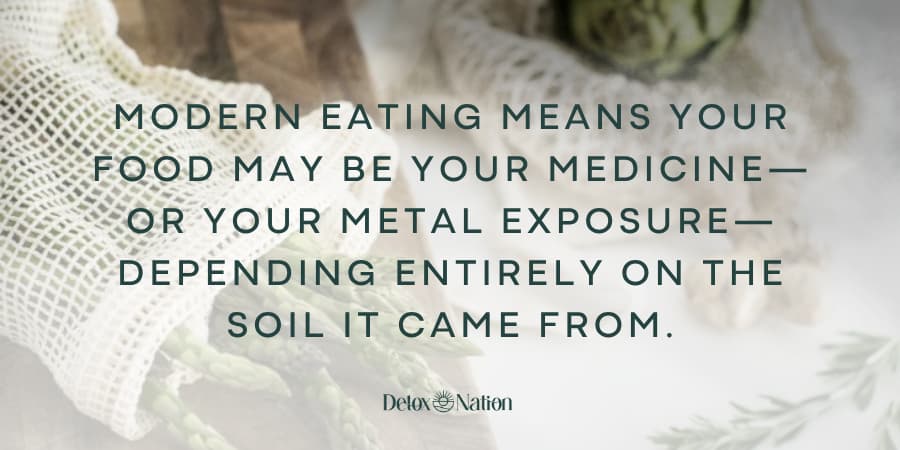
The Body Can’t Detox What It Can’t Drain
Here’s the painful irony: cadmium damages the very systems you need to get rid of it.
- It messes with your kidneys, which are your main filter system (2, 4, 5, 9, 11, 15, 23, 24, 25).
- It stalls liver bile flow, which is essential for fat-soluble toxin removal.
- It depletes minerals like zinc and selenium, which are critical for detox enzymes.
- It shuts down glutathione production, so your cellular cleanup crew goes on strike (9, 26, 28).
So not only is cadmium hard to get out—it also makes you worse at getting it out.
This is why the longer it stays, the worse you feel. It’s not “just aging,” it’s not “just stress,” and no, it’s not in your head. It’s in your tissues. And it’s actively interfering with your ability to heal.
The Snowball Effect
Exposure to cadmium is rarely a solo act. Once it’s in the system, it:
- Lowers your threshold for other toxins like mercury, lead, and mold.
- Makes you more sensitive to EMFs and stress.
- Worsens inflammation in a way that can trigger autoimmune flares, pain syndromes, and hormone chaos.
And over time, this slow burn becomes your “new normal.” You don’t realize how bad you feel – until you start to feel better.
Stop Guessing. Start Healing.
If you're ready to go deeper, our Healing Labs offer real, tissue-level testing that reveals what your bloodstream can’t. This is where clarity begins.
Explore Healing LabsWhat You Can Do About It
Here’s the good news: cadmium exposure is fixable.
Not overnight and not with another round of random supplements from your Instagram feed—but yes, your body can release it.
You’re not broken. You’re burdened. And the healing begins with lightening that load.
Open Your Drainage Pathways
This is where most people go wrong. You cannot detox if your drainage is clogged.
Before you go after cadmium, your body needs a clear exit strategy. That means:
- Supporting kidney filtration with targeted herbs and hydration strategies
- Ensuring bile flow with bitters and gentle liver support
- Stimulating lymph movement with dry brushing, castor oil packs, and movement
- Repairing your gut lining and reducing constipation (because if you’re not pooping, you’re reabsorbing toxins)
Mineral Support
Cadmium displaces critical minerals like zinc, calcium, selenium, and magnesium. Restoring these is non-negotiable. It’s like changing the locks so cadmium can’t sneak back in.
Minerals do the heavy lifting in detox—they don’t get enough credit, but they change everything. Replenishing the right ones supports enzyme activity, mitochondrial function, and helps re-regulate your body’s terrain.
Gentle, Strategic Mobilization
This is where we safely encourage the body to release stored cadmium—without flooding your system or making you feel worse.
How?
- Using natural binders like activated charcoal, humic/fulvic acids, or bentonite clay.
- Supporting glutathione production naturally (through precursors like NAC, glycine, and selenium).
- Timing mobilization with your body’s energy and resilience—not just because it’s Tuesday and you’re impatient.
This part must be customized because everyone’s terrain is different. What works for one person could derail another. That’s why we don’t do one-size-fits-all detoxes here—and never will.
Nervous System Repair (Don’t Skip This)
If you don’t calm the nervous system, you’ll stay in fight-or-flight—and your body will hold onto toxins like its life depends on it.
Because from your body’s perspective, it does.
That’s why we include biofield repair, Vagus nerve support, and emotional clearing tools in our programs.
Because if you’re still stuck in survival mode, your body won’t feel safe enough to release the junk it’s been storing.
This isn’t a “detox.” It’s a return to flow.
You don’t need to do everything at once. You just need to know the next right step.
And that step might be as simple as – curiosity.
Curiosity about what’s happening in your body.
Curiosity about why you’re still tired.
Curiosity about what’s possible when your body isn’t carrying around decades of toxic weight.
And curiosity, my friend, is the doorway to healing.
Your Next Step
Before you start throwing binders at your body (please don’t), you need clarity: is cadmium playing a role in your symptoms?
We’ve built two powerful tools to help you figure that out:
Free Toxicity Self-Assessment
Based on your symptoms, history, and lifestyle, this quick assessment helps you uncover whether toxic metals like cadmium might be part of your health puzzle. Take the free Toxicity Self-Assessment now
Healing Labs
If you’re ready to go deeper, our Healing Labs offer real testing—the kind that looks at tissue burden, not just what’s floating in your bloodstream. This is where you stop guessing and start getting answers. Explore Healing Labs here
Because you don’t need to do this alone. You’ve got a community of scrappy, smart, and fiercely resilient people who refuse to give up on their bodies standing behind you.
You’re not too late. You’re right on time. Let’s get to work.

